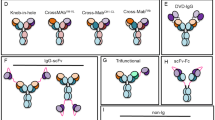Abstract
Antibodies have long been used in biomedical science as in vitro tools for the identification, purification and functional manipulation of target antigens; they have been exploited in vivo for diagnostic and therapeutic applications as well. Recent advances in antibody engineering have now allowed the genes encoding antibodies to be manipulated so that the antigen binding domain can be expressed intracellularly. The specific and high-affinity binding properties of antibodies, combined with their ability to be stably expressed in precise intracellular locations inside mammalian cells, has provided a powerful new family of molecules for gene therapy applications. These intracellular antibodies are termed ‘intrabodies’. Two clinical protocols have been approved by the RAC for the use of intrabodies in the treatment of an oncologic and an infectious disease. Their clinical use will in all likelihood become widespread if these initial studies show ‘proof in principle’. In this article, the studies from laboratories that have used intrabodies as molecular reagents for cancer therapy and for the control of infectious diseases will be reviewed and future directions of this technology will be discussed.
Similar content being viewed by others
Author information
Authors and Affiliations
Rights and permissions
About this article
Cite this article
Marasco, W. Intrabodies: turning the humoral immune system outside in for intracellular immunization. Gene Ther 4, 11–15 (1997). https://doi.org/10.1038/sj.gt.3300346
Issue Date:
DOI: https://doi.org/10.1038/sj.gt.3300346
- Springer Nature Limited
Keywords
This article is cited by
-
Intrabody targeting vascular endothelial growth factor receptor-2 mediates downregulation of surface localization
Cancer Gene Therapy (2017)
-
Molecular cloning and characterization of a single-chain variable fragment antibody specific for benzoylecgonine expressed in Escherichia coli
The Journal of Microbiology (2008)
-
Novel antibodies as anticancer agents
Oncogene (2007)
-
Generation and functional characterization of intracellular antibodies interacting with the kinase domain of human EGF receptor
Oncogene (2003)
-
The production and application of single-chain antibody fragments
Folia Microbiologica (2003)




